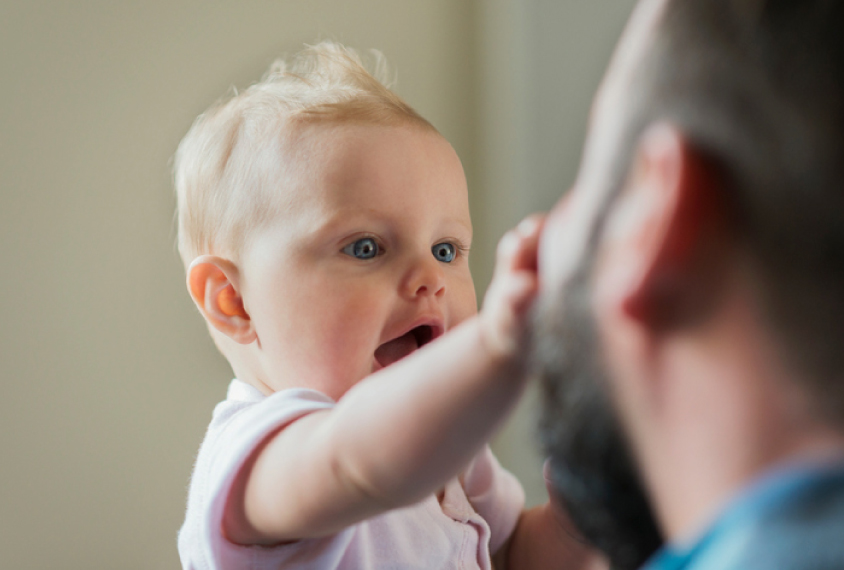
Parents beat clinicians at detecting autism signs in infants
Parents who have one child with an autism diagnosis can more accurately spot signs of the condition in their younger child at 12 months of age than clinicians can.
Parents who have one child with an autism diagnosis can more accurately spot signs of the condition in their younger child at 12 months of age than clinicians can, according to a new study1. The advantage fades by 18 months of age, however.
The most accurate results at 18 months came from combining parents’ and clinicians’ insights.
The findings suggest that surveying knowledgeable parents could move up the date of autism diagnosis, enabling therapy to begin sooner.
“Parents know their child well and can provide invaluable information that may be missed during brief observation by a clinician,” says lead investigator Lonnie Zwaigenbaum, professor of pediatrics at the University of Alberta in Edmonton, Canada.
Some of the signs that parents identified at 12 months, such as repetitive behaviors and unusual sensory interests, occur rarely, so a clinician would be unlikely to catch them during a brief visit, Zwaigenbaum says.
“At 12 months, I think the reality is none of us know what to do. I wouldn’t be surprised if some parents have a sense that something is not quite right,” says Catherine Lord, director of the Center for Autism and the Developing Brain at New York-Presbyterian Hospital in New York, who was not involved in the work. At that age, clinicians ought to listen to parents who have experience with autism, Lord says.
Rating reactions:
Zwaigenbaum and his collaborators studied 188 infant siblings of children with autism. These ‘baby sibs’ are at increased risk for autism.
Parents answered a 26-question survey, the Autism Parent Screen for Infants, in which they rated their babies’ behaviors. And clinicians assessed the same children using the Autism Observation Scale for Infants. This requires them to watch and interact with the infants for 15 minutes and rate their behaviors.
The two surveys have 19 items in common, including questions about eye contact, hand-eye coordination, social smiling, repetitive motion and back-and-forth vocalizations.
Parent and clinician answers often differed on the overlapping questions, and parents noticed behaviors missed by clinicians at both 12 and 18 months. At 12 months, the clinicians did not spot any behaviors the parents had overlooked; at 18 months, they noticed one behavior the parents had missed: reacting to changes in facial expressions.
Once the children had reached age 3, independent clinicians assessed and diagnosed 59 (31 percent) of them with autism.
The researchers found that parents’ answers on the 12-month survey had correctly predicted an autism diagnosis in 30 (51 percent) of those 59 children. Clinicians’ correct prediction rate was slightly higher — 38 children (64 percent) — but they were wrong much more often than the parents. The parents incorrectly predicted autism in 24 children (19 percent), versus 54 children (41 percent) for the clinicians.
Taken together, the results show that parents predict autism more accurately than clinicians at this age, says Lori Sacrey, study investigator and postdoctoral fellow at the University of Alberta. In addition, parents picked up more individual behaviors at 12 months that augured autism than clinicians did.
On the lookout:
At the 18-month screen, parents’ answers correctly predicted an autism diagnosis in 26 (44 percent) of the children, and incorrectly predicted the condition in 15 (12 percent).
Clinicians’ answers at 18 months correctly predicted autism in twice as many children as the parents’ — 48 (81 percent). (Clinicians were still wrong much more often, however, incorrectly predicting autism in 62 children, or 42 percent.)
The study appeared 22 January in Autism Research.
Clinicians still bring a lot of value to the diagnostic process, however. This fact is evident in the 18-month assessment from this study and in other research using the toddler Autism Diagnostic Observation Schedule, Lord says. “It isn’t useful as a pronouncement that parents are more important than clinicians,” she says.
One promising aspect of the study is that the children later diagnosed with autism are generally at the mild end of the spectrum, says Deborah Fein, professor of psychological sciences and pediatrics at the University of Connecticut, who was not involved in the study.
“It means that even kids with pretty high-functioning autism can be picked up early; it doesn’t have to be the kids with big delays,” she says.
The study should be repeated in the general population, and involve parents of children who do not have an autism diagnosis, Fein says. Parents of a child with autism typically know more about the condition than most people and are more attuned to its signs in a younger sibling.
Zwaigenbaum is repeating the study in toddlers at low risk for autism.
References:
- Sacrey L.R. et al. Autism Res. Epub ahead of print (2018) PubMed
Recommended reading

New organoid atlas unveils four neurodevelopmental signatures
Explore more from The Transmitter
Snoozing dragons stir up ancient evidence of sleep’s dual nature

The Transmitter’s most-read neuroscience book excerpts of 2025


